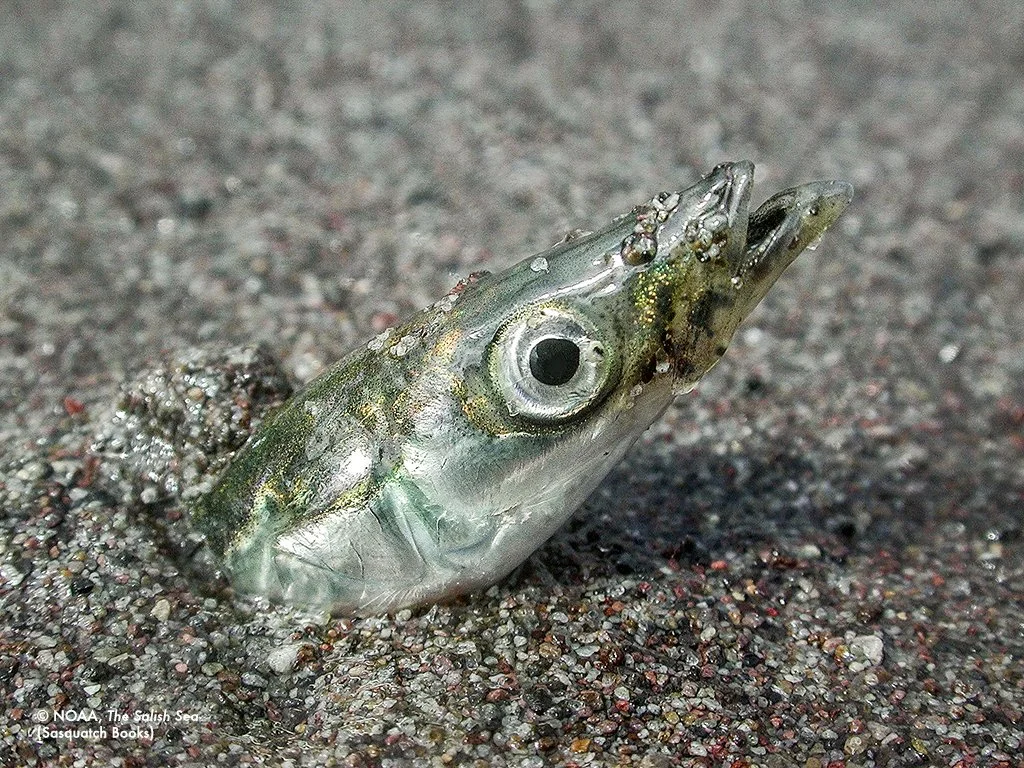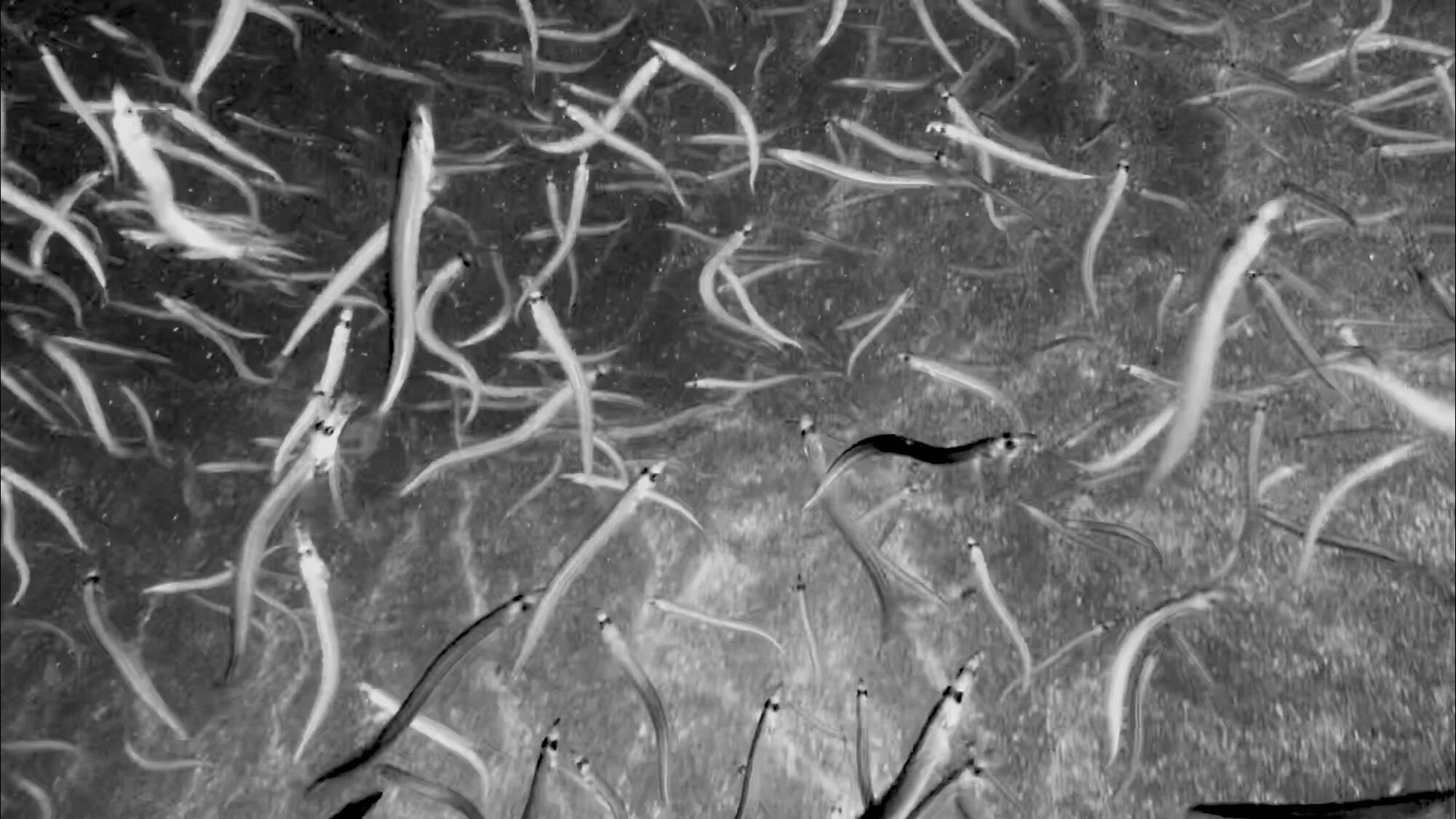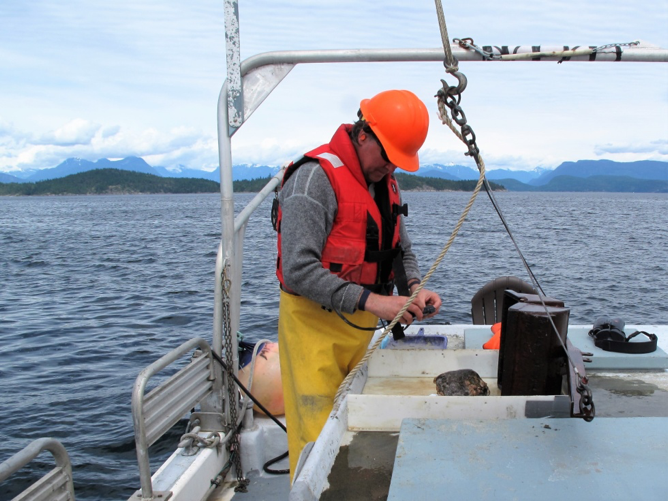“Well-aerated, well-sorted, medium-to coarse-grain...” might sound like a wine flavor profile, but it actually describes the type of sandy, sea floor habitat preferred by Pacific sand lance. Sand lance play a crucial role in the Salish Sea’s food web, providing nutrition for everything from seabirds to whales, salmon, and lingcod. It’s thought that one sand wave field in the San Juan Archipelago alone could be home to over 12 million sand lance, but we’re only beginning to learn about their habitat.
Going Deep to Study the Small But Vital Sand Lance
How do you conduct research on tiny, elusive fish that live hundreds of feet below the surface, burrow under the sandy seafloor, and are only half the size of a dollar bill? Like any challenge in marine biology, when there’s a will, there’s a wave.
In 2018, SeaDoc and Ocean Gate worked together to bring a submersible to the San Juan Islands for researchers needing such a platform for their work. A team of scientists from the Alaska Fisheries Science Center, University of Washington, Moss Landing Laboratories, and Tombolo Mapping Laboratory was awarded sub time to study a very important forage fish.
We Brought a Sub to the Salish Sea (PHOTOS)
It’s amazing what you can get done if you have the right tools.
About a year ago, we made the decision to bring a manned submersible to the San Juan Islands for a week of seafloor research. We put out a call for proposals and ultimately decided on three great projects studying deep-dwelling red urchins, sand lance habitat and the effects of seafloor trawling.
In most cases, scientific results arrive slowly after data is processed and analyzed, but when a tool is offered up that grants a new perspective for observation, exciting discoveries can arrive quickly. We saw that during our week with the OceanGate submersible, with team after team brimming with excitement after popping out of the sub after several hours of deep sea immersion.
Science on the Seafloor: A Research Submarine is Coming to the San Juan Islands
What do red urchins, Pacific sand lance and scientific trawling of the seafloor all have in common?
All three exist at depths that can’t be easily observed by scientists -- that is unless you bring in some fancy tools. Enter SeaDoc and our friends at OceanGate Foundation, with whom we’ve partnered to bring a submarine (a manned submersible called Cyclops 1) to the San Juan Islands this September. We funded three unique research projects, none of which would be possible without this incredible piece of machinery to carry our teams.
Where do Pacific sand lance live and why does it matter?
Sand lance are a small forage fish known for burrowing into the sand at the bottom of the sea. They’re largely out of human sight, but it would be a mistake to ignore them because they play a crucial role on the bottom of the food web that runs all the way to the top.
They’re an important food source for sea birds like the marbled murrelet and fish like Chinook salmon. If the Pacific sand lance population struggles, a negative ripple effect could be seen all the way up to southern resident killer whales, which eat Chinook salmon.
To date, our knowledge of Pacific sand lance habitat is basic at best, making it very hard to monitor and protect these important fish. That’s why Dr. Cliff Robinson of the Pacific Wildlife Foundation and Dr. Douglas Bertram of Environment & Climate Change Canada pitched a proposal to dig in (read the next few paragraphs and you’ll discover this is a pun!) and enhance the current GIS-based seafloor model that best describes sand lance habitat in the Salish Sea. Defining their habitat and monitoring their population can set the stage for future conservation efforts.
SeaDoc is funding their study, which went into full-swing in 2017. The team recently shared some cool photos from their fieldwork.
“Sand lance are important because they take plankton and convert it into fat,” said SeaDoc Society Science Director Dr. Joe Gaydos. “Tons of birds, fish and mammals eat them. If you can identify and protect the habitat they need, it benefits sand lance and all of the animals that eat them.”
Sand lance are unique in that they bury themselves in medium-coarse sand with low silt content when they’re not feeding in the water column. Robinson and Bertram’s goal is to refine their model to be able to identify and map this important habitat in the Salish Sea. To look for the presence or absence of buried sand lance in potential habitat, the team is taking boats out and using a claw-like grab sampler to pull up sediment or using underwater drop cameras to look for fish entering or emerging from the sand.
We’ll keep you updated as they continue their study.
Taking Care of the Little Things
By Bob Friel
Everybody loves the Salish Sea’s killer whales, playful porpoise, and puppy-like seals. Birders flock here to see such feathered favorites as rhinoceros auklets, tufted puffins, and marbled murrelets. And no fish anywhere is as exalted as our Chinook, the king salmon, appreciated as sport fish, table fare, and cultural icon.
But where’s the love for the sand lance? Who here is a herring hugger?
Forage fish are the Rodney Dangerfields of the sea—they get no respect. Even that catchall name for the many different species of small schooling fish suggests they exist only to serve as self-propelled snacks. However, without these little fish that feed at the base of the food web, converting plankton into silvery packets of energy, there wouldn’t be any of those other more charismatic critters. No auklets, no puffins, and no king salmon. And without king salmon, of course, the Southern Resident Killer Whales disappear.
It’s impossible to exaggerate the importance of forage fish to the overall health of the Salish Sea. Unfortunately the research and, where needed, recovery work on these vital species hasn’t been commensurate with their value. So SeaDoc is investing in forage fish by funding two new projects, one on sand lance and the other on herring.
With everything from seabirds to sea lions hunting them, Pacific sand lance (Ammodytes personatus) have evolved an ingenious survival strategy. Whenever they’re not grazing on plankton in the water column, they tuck themselves into the sandy seabed to hide from predators and wait for their next feeding opportunity.
We know that Pacific sand lance nourish myriad crucial Salish Sea species, and a recent Northwest Straits Initiative / SeaDoc study showed smaller sand lance are widely distributed in our near shore waters year round, with population peaks in the summer. But we still don’t know the answers to some basic questions about these fascinating little fish, such as: Where exactly do they like to hide? How many of them are there? And, are their populations stable?
Now, we’re funding a new project that will use underwater video and a bottom-biting oceanographic tool called a Van Veen Sampler to ascertain the exact types of sea floor where the sand lance prefer to bury (too silty and they can’t breathe; too gravelly and they can injure themselves while tunneling). Co-investigators Drs. Cliff Robinson (Pacific Wildlife Foundation / University of Victoria) and Doug Bertram (Environment and Climate Change Canada) and their team will precisely map those habitats, build an improved model for predicting seafloor use by sand lance, and re-sample study sites monthly to look at population health and seasonal variability.
Compared to our knowledge base on sand lance, we know quite a bit about Salish Sea herring. As the foundational forage fish—the energy source that spins a huge part of our food web—healthy herring populations are considered so critical that the Puget Sound Partnership lists them as one of our “vital signs.” Simply checking the dwindling numbers of many herring stocks on the Washington State side of the Salish Sea, tells you that the ecosystem is in trouble.
The herring stock that spawns at Cherry Point, site of the state’s largest oil refinery, was once the most prolific in all of Puget Sound. Since 1973, the Cherry Point population has crashed by more than 93 percent. While this stock and others on the U.S. side are faltering, in British Columbia's Strait of Georgia they’re currently booming. With your support, our research is designed to find out reasons why some stocks are hurting and how to recover them as soon as possible.
Helping herring will never be as sexy as salmon conservation, but it’s every bit as important to the health of our ecosystem. So SeaDoc is jumpstarting the recovery process for Puget Sound herring by funding a joint US / Canadian team co-led by Drs. Tessa Francis (Puget Sound Institute, UW Tacoma) and Dayv Lowry (WA Department of Fish and Wildlife) that will act as the nexus for relevant data and expertise. This project will determine the specific threats harming the southern herring populations, assess all of the stocks, and evaluate the state of the science, policies, and ongoing recovery efforts in order to ultimately produce a comprehensive Salish Sea herring conservation and management plan.
Thanks to your support, both new projects continue the SeaDoc Society’s mission to provide the science that’s helping to heal our Salish Sea.
This holiday season, show some love to the lowly forage fish. Go ahead: hug a herring.
Banner photo: Rhinocerus auklet with sand lance. Courtesy of Phil Green, from The Nature Conservancy.











